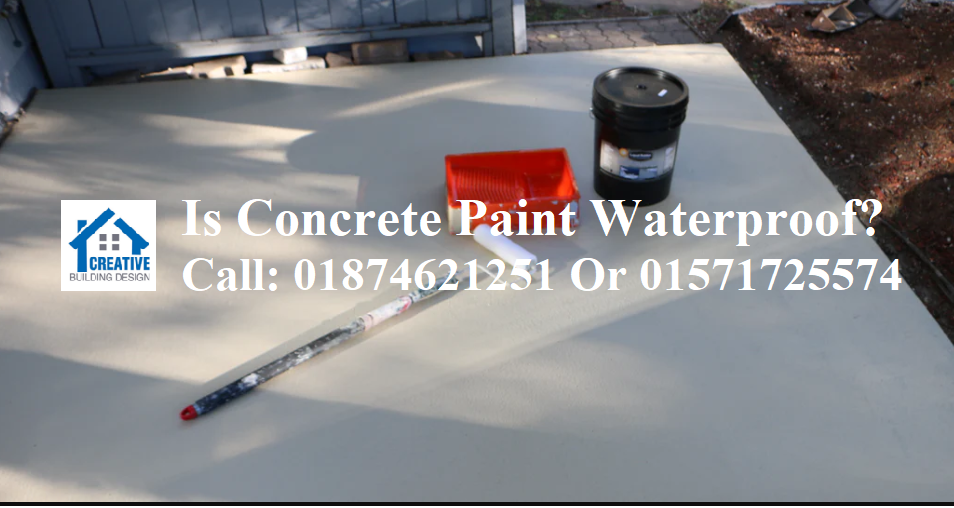
If you’re looking for waterproof paint for concrete, there are a few different options to choose from. One is a latex-based waterproofing paint, which can be applied to both interior and exterior concrete surfaces. This type of paint is typically white or tinted, and it forms a barrier that prevents water from penetrating the concrete.
Another option is epoxy-based waterproofing paint, which is more durable and long-lasting than latex-based paint. Epoxy paint is typically used on exterior concrete surfaces, as it can withstand harsh weather conditions. It’s also available in a variety of colors, so you can choose one that best suits your needs.
No matter which type of waterproof paint you choose, be sure to follow the manufacturer’s instructions carefully to ensure the best results. Types of concrete paint:
There are two main types of concrete paint: latex-based and epoxy-based. Latex-based paint forms a barrier that prevents water from penetrating the concrete, while epoxy-based paint is more durable and long-lasting. Epoxy paint is typically used on exterior concrete surfaces, as it can withstand harsh weather conditions.
Contents
- 1 What is the best concrete waterproofing paint?
- 2 Is cement concrete waterproof?
- 3 Which is the best waterproof paint for concrete?
- 4 Can you use drylok extreme on basement floors?
- 5 What is the importance of waterproof paint for concrete outside?
- 6 How to waterproof concrete basement walls?
- 7 Should I seal my basement concrete walls?
- 8 Does basement waterproofing actually work?
- 9 Final Words:
What is the best concrete waterproofing paint?
The best concrete waterproofing paint depends on your needs and preferences. If you’re looking for waterproof paint that can be applied to both interior and exterior concrete surfaces, latex-based waterproofing paint is a good option. If you need a more durable and long-lasting paint, epoxy-based waterproofing paint is a better choice. The popular concrete waterproofing paint brand is Drylok and RadonSeal.
Is cement concrete waterproof?
Cement concrete is not waterproof on its own, but it can be made waterproof with the addition of a waterproofing agent. There are a variety of waterproofing agents that can be added to concrete, including latex-based paints, epoxy-based paints, and sealants. Cement concrete waterproofing used over the years has shown to be an effective way to waterproof your basement or garage.
Which is the best waterproof paint for concrete?
There are a few different waterproof paints for concrete that you can choose from, including latex-based paints, epoxy-based paints, and sealants. The best waterproof paint for concrete depends on your needs and preferences. If you’re looking for waterproof paint that can be applied to both interior and exterior concrete surfaces, latex-based waterproofing paint is a good option. If you need a more durable and long-lasting paint, epoxy-based waterproofing paint is a better choice.
Can you use drylok extreme on basement floors?
Drylok Extreme is a waterproofing paint that can be used on both interior and exterior concrete surfaces. It’s available in a variety of colors, so you can choose one that best suits your needs. The lifespan of drylok paint is around 5-10 years. So it’s more durable if compare with latex-based waterproofing paint. In some cases, drylok extreme paint achieves the most popularity.
What is the importance of waterproof paint for concrete outside?
Waterproof paint for concrete is important because it helps to protect the concrete from water damage. Water can seep into the concrete and cause it to crack and crumble, so it’s important to keep the concrete sealed and protected. Waterproof paint can also help to extend the life of the concrete by protecting it from the elements. The price of waterproof paint is around 100 t0 120 tk per square foot.
How to waterproof concrete basement walls?
One of the best ways to waterproof concrete basement walls is to use a waterproofing sealer. This will help keep water from seeping through the concrete and causing problems.
There are two main types of waterproofing sealers: waterproofing paints and waterproofing membranes. Waterproofing paints work by creating a barrier between the concrete and the water. Waterproofing membranes work by blocking water from entering the concrete.
Applying a waterproofing sealer is a fairly simple process. First, you will need to clean the surface of the concrete. Next, you will apply the sealer using a brush, roller, or sprayer. Once the sealer is dry, you should apply a second coat for extra protection. Applying a waterproofing sealer is a fairly simple process. First, you will need to clean the surface of the concrete. Next, you will apply the sealer using a brush, roller, or sprayer. Once the sealer is dry, you should apply a second coat for extra protection.
Should I seal my basement concrete walls?
Many people seal their basement concrete walls to prevent water damage, mold, and other issues. However, there are a few things to consider before sealing your basement concrete walls. First, make sure that your basement is properly ventilated. If your basement is not properly ventilated, sealing the concrete walls could trap moisture and lead to further problems. Second, consider the type of sealer you use. Some sealers are more effective than others at preventing water damage, mold, and other issues. Make sure to read the labels of the sealers you are considering to ensure that they will be effective in your basement. Finally, be sure to follow the site engineers instructions carefully when applying the sealer to your basement concrete walls.
Does basement waterproofing actually work?
Yes, basement waterproofing can be effective at preventing water damage, mold, and other issues. If you have a question can you waterproof a basement from the inside? You will get an answer from here, you can waterproof your basement from the inside. However, you need to make sure that your basement is properly ventilated. If your basement is not properly ventilated, sealing the concrete walls could trap moisture and lead to further problems. Cost of exterior waterproofing a basement can vary depending on the size of your basement, the type of sealer you use, and the difficulty of the project.
Final Words:
There is no definitive answer to this question as it depends on the specific brand and type of concrete paint that you use. Some concrete paints are more waterproof than others, so it is best to check the manufacturer’s instructions before using them.
Related Post:
- Best Waterproofing & Damp Proofing Company
- Waterproofing And Dampproofing Specialist In Bangladesh
- Acrylic Roof Coating Waterproofing
- Bituminous Membrane in Bangladesh
- Cementitious waterproofing in Bangladesh
- Concrete Waterproofing Company in Bangladesh
- Foundation Waterproofing Membrane In Bangladesh
- How To Make Concrete Roof Waterproof?
- How To Waterproof Basement Concrete Floor?
- How To Waterproof Concrete Wall?
- Polyurea Spray Coating
- Polyurethane Waterproofing In Bangladesh
- Rooftop Waterproofing In Bangladesh
- Waterproofing Chemical in Bangladesh
- Best Waterproofing Applications for Your Flat Roof
- Waterproofing In Bangladesh
- Waterproofing Membrane In Bangladesh
